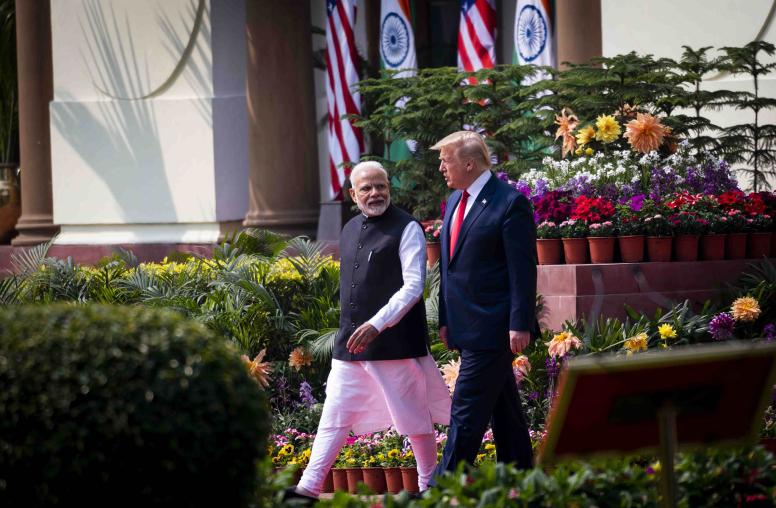To Secure Shared Environments, We Must Protect Indigenous Peacebuilders
Humanity observes our 53rd annual Earth Day this week while worsening our assault on our planetary home. Arguably our most critical protectors against this self-harm are Indigenous people who, only about 6 percent of us, protect 80 percent of Earth’s biodiversity. Yet powerful elites, armed groups and business interests attack and kill politically marginalized Indigenous environmentalists to continue clawing wealth out of ecosystems from the Amazon and Congo basins to the Himalayas. Any real hope of reversing our environmental degradation will require U.S. and international policymakers to strengthen protections for Indigenous environmentalists.

The Global Assault on Environmentalists
Earth Day arrives only weeks after the main U.N. body on climate change cited the work of many hundreds of scientists in this grim consensus: Climate change is now so grievous “a threat to human well-being and planetary health” that our “window of opportunity to secure a livable and sustainable future for all” is “rapidly closing.”
Those most endangered include Indigenous people, over 475 million, who safeguard their ecosystems and the bulk of Earth’s remaining biodiversity with their traditional, generations-old expertise. Communities such as the Amazon’s Yanomami and Karipuna, or northeast India’s Khasi, are attacked as governments, industries and other powerful interests seize lands to mine, drill for oil, clear-cut timber or dam rivers. Attackers kill four environmental defenders every week — 1,733 of them since 2012 — and this murderous pace has accelerated, reports the human rights group Global Witness. In 2021, 40 percent of those killed were Indigenous, with most attacks in Latin America and Asia.
Activists in a coalition known as ALLIED document a wider campaign of attacks, including death threats, beatings, sexual assault, smear campaigns and arbitrary imprisonment or judicial harassment. In five of the most dangerous countries for environmentalists — Colombia, Guatemala, Kenya, Mexico and the Philippines — hundreds of non-lethal attacks have presaged deadlier violence. The group reports that most governments do not specifically monitor attacks on environmental defenders, leaving that task to civil society and thus failing to effectively counter the violence.
Northeast India: Environmental Losses and Violence
One campaign against Indigenous environmentalists roils India’s eight northeastern states. There, 45 million indigenous people of 272 ethnicities live amid forested mountains and valleys — a region almost as large as Burkina Faso or Colorado. At the eastern end of the Himalayan Mountains, northeast India falls within one of Earth’s 36 “hotspots” where environmentalists say biodiversity is at particular risk.
For decades, India’s northeast has faced border clashes with China, communal conflicts and insurgencies that have killed more than 50,000 people. In the region, India has leaned heavily on its Armed Forces Special Powers Act, which provides impunity for violence by the military. Under this historically militarized governance, the northeast’s Indigenous peoples have been killed, and their visions for development and governance ignored, by authorities. India’s Supreme Court ordered government investigations into civic groups’ accounts of 1,528 extrajudicial killings by Indian forces just between 2000 and 2012 in the state of Manipur. Nearly six years later, prosecutions have not begun.
Central government power, allied to business interests, drives most deforestation in the northeast, which is 8 percent of India’s territory but has 24 percent of its forest cover. Forestlands are slashed for farming by settlers; government-backed oil, gas and mining projects; and, most threatening of all, dams. The government aims to make the northeast “India’s future powerhouse” by building more than 100 dams, including massive projects that would inundate entire valleys. Prime Minister Narendra Modi says negotiations with insurgents have let the government lift the special military powers in many areas and accelerate development. In the northeast, “obstacles such as corruption, discrimination, violence and … [partisan] politics were removed,” Modi declared.
A grassroots movement, led largely by Indigenous people, students and women, opposes the dam-driven model of development. They cite the northeast’s severe risk of earthquakes; flood disasters created by existing dams; and the displacement of thousands of families by a single dam in Tripura state. Indian authorities arrest and harass campaigners who oppose government-backed projects. Environmentalists have been shot dead, their killers never identified. Few cases are as publicly reported as the 2016 arrest of a Buddhist lama, Lobsang Gyatso, for opposing dam construction. People protesting his arrest were shot dead — six of them by police, according to a local environmental group. Officials continue to detain and threaten Indigenous activists, northeast civil society organizations declared last month.
In Latin America: Not Just the Amazon
As moneyed, powerful elites slash Latin America’s globally vital forests for more farmland, minerals and timber, international attention — via books, films, protests, even lawsuits — has focused heavily on Brazil. But most Latin American states continue to allow the dual assault on Indigenous peoples and their biodiverse homelands.
A struggle often overlooked is Nicaragua’s. Indigenous and campesino communities led protests to halt an attempt by President Daniel Ortega’s government to build a massive Chinese-funded canal that would have smashed through pristine forestlands of Miskito, Rama and other Indigenous peoples. In 2018, Nicaraguans protested what they said was the government’s poor response to massive fires across the Indio Maíz biological reserve. The reserve is Nicaragua’s second-largest lowland rainforest, part of the Mesoamerican Biological Corridor and home of the Rama-Kriol people. Those protests energized the years-long civic uprising against Ortega’s rule.
More than 260,000 Nicaraguans have fled violence and oppression as refugees, mainly to the United States and Costa Rica — and violent struggles over resources have embroiled Indigenous people and their lands. Farmers clear Indigenous forestlands to raise cattle; settlers illicitly clear forest for its timber. Ortega’s government has allowed such incursions and has promoted gold extraction by issuing mining permits — some within legally protected reserves, according to reports from the Inter-American Commission on Human Rights, the nongovernmental Oakland Institute and the Nicaragua-based River Foundation. Whether passive or active, official facilitation of encroachment has fueled killings, rapes, forced displacement and other violence against Indigenous peoples by armed gangs aligned with land-grabbers, environmental activists and independent analysts say.
In Venezuela, Indigenous peoples, about 3 percent of the population, remain the most marginalized. Although the 1999 Constitution established state protections for Indigenous languages, cultures, and territorial rights, those communities still face extreme violence and oppression by state and non-state actors. Yet Indigenous peoples’ plight is overshadowed by Venezuela’s national humanitarian and political crises. Indigenous communities bear the brunt of the Nicolás Maduro government’s extractive mining policies, particularly in the rural Amazonas and Bolivar states bordering Brazil. Of Venezuela’s 40-plus ethnic groups, the Yanomami and Pemón are among the most victimized. Deep in the Amazon rainforest, the Yanomami suffer deaths and displacement from attacks, abuses and diseases inflicted by illegal miners, the Venezuelan military and non-state armed groups. As the Pemón people in Bolivar resist mining activities, security forces severely suppress their protests, killing, detaining and reportedly torturing Pemón activists or community members.
How Partners Can Help
Preserving our planet’s endangered ecosystems requires all the resources and allies we can muster. U.S. and international policymakers should recognize indigenous environmental defenders as irreplaceable allies, and should strengthen policies and practices to protect them. Key steps include:
- International diplomacy to urgently press governments and regional bodies to explicitly monitor and prosecute attacks on Indigenous environmentalists — a task that, as noted above, many countries now leave to civil society. Governments would do well to build this capacity in collaboration with the new U.N. special rapporteur on environmental defenders.
- Improved implementation of national laws and international resolutions and treaties to protect Indigenous communities’ rights and the environment. Applicable instruments include U.N. declarations on the rights of Indigenous peoples (2007) and of human rights defenders (1998), and the International Labor Organization’s Indigenous and Tribal Peoples Convention. The 2018 Escazu Agreement among Latin American and Caribbean states protects environmental defenders; it has been ratified by 15 countries of more than 30 in the region. A meeting of its members next week is an opportunity to advance its ratification, notably by Brazil.
- Ending Indigenous communities’ injurious marginalization from governance — locally, nationally and internationally. One global example: When last year’s U.N. climate conference, COP27, established a Loss and Damage Fund to support countries most harmed by climate disasters, an Indigenous caucus (the International Indigenous Peoples' Forum on Climate Change) decried the fund’s omission of any reference to Indigenous communities. The group urges recognition of the particular losses of Indigenous populations and a real inclusion of Indigenous representatives in all climate initiatives. Advocates criticize similar omissions of Indigenous voices and concerns in the 2022 U.N. Biodiversity Conference (COP15) and its agenda (called the 30x30 Agreement) for biodiversity protection.
Earth’s degrading climate speaks clearly: Our modern states and economies have erred disastrously in silencing and ignoring our Indigenous neighbors’ plea for respect and care toward our shared planet. Preserving a viable Earth for our children means first hearing and heeding those neighbors’ voices.
The authors work at the U.S. Institute of Peace. Chris Collins is a senior program assistant and Emmanuel Davalillo Hidalgo is a program officer in the Institute’s Climate, Environment and Conflict unit; Binalakshmi Nepram is a senior advisor and Mona Hein is a visiting scholar on the Religion and Inclusive Societies team.



